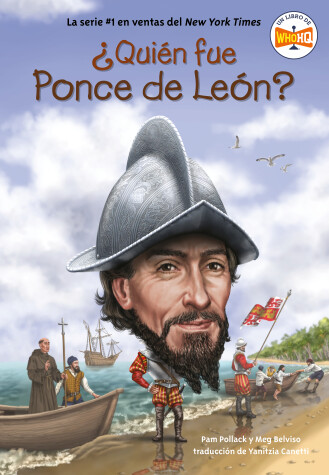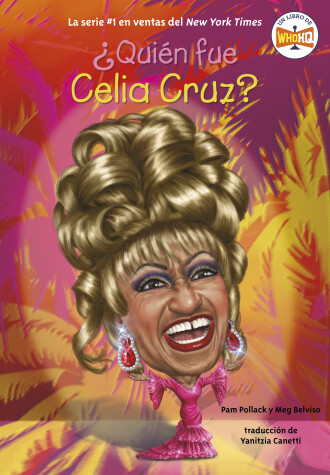¿Quién fue?
2 total works
Learn the story of Spanish conquistador Juan Ponce de León and how he shaped the history of both Florida and Puerto Rico during the Age of Exploration.
Conoce la historia del conquistador español Juan Ponce de León y cómo influyó en la historia de Florida y Puerto Rico durante la Era de las Exploraciones.
In the early 1500s, Ponce de Leon was was one of the most important Spanish military figures in the Caribbean. He made his first voyage across the Atlantic with Christopher Columbus and then, after years of battle with the native Taino, became the first governor of Puerto Rico. Although the story of his search for the Fountain of Youth is entirely fictional, his noteworthy expedition to - and naming of - Florida is one of his greatest legacies.
A principios del siglo XVI, Ponce de León era una de las figuras militares españolas más importantes del Caribe. Realizó su primer viaje a través del Atlántico con Cristóbal Colón y luego, tras años de lucha con los nativos taínos, se convirtió en el primer gobernador de Puerto Rico. Aunque la historia de su búsqueda de la Fuente de la Juventud es totalmente ficticia, su notable expedición a Florida (y su nombramiento) es uno de sus mayores legados.
Conoce la historia del conquistador español Juan Ponce de León y cómo influyó en la historia de Florida y Puerto Rico durante la Era de las Exploraciones.
In the early 1500s, Ponce de Leon was was one of the most important Spanish military figures in the Caribbean. He made his first voyage across the Atlantic with Christopher Columbus and then, after years of battle with the native Taino, became the first governor of Puerto Rico. Although the story of his search for the Fountain of Youth is entirely fictional, his noteworthy expedition to - and naming of - Florida is one of his greatest legacies.
A principios del siglo XVI, Ponce de León era una de las figuras militares españolas más importantes del Caribe. Realizó su primer viaje a través del Atlántico con Cristóbal Colón y luego, tras años de lucha con los nativos taínos, se convirtió en el primer gobernador de Puerto Rico. Aunque la historia de su búsqueda de la Fuente de la Juventud es totalmente ficticia, su notable expedición a Florida (y su nombramiento) es uno de sus mayores legados.
How did a working-class girl from Cuba become a symbol of artistic freedom for Cuban Americans and the "Queen of Salsa"? Find out in this addition to the Who HQ library!
¿Cómo una niña de clase trabajadora de Cuba se convirtió en un símbolo de libertad artística para los cubanoamericanos y en la "Reina de la Salsa"? ¡Descúbrelo en este nuevo libro para la bibliotheca de Who HQ!
Although her family and friends know her as Úrsula Hilaria Celia de la Caridad Cruz Alfonso, the world refers to her simply as Celia Cruz. Starting her career in 1950, Celia grew increasingly popular as the new lead singer of the Cuban band Sonora Matancera. Her exceptional vocal range and flashy costumes made fans fall in love with her.
Celia's talent took her all around the world, including the United States. After Fidel Castro came to power in Cuba, she wasn't allowed to return to her native country. She and other Cubans who were exiled used their music to express their love for their homeland.
Celia rose to the top of the charts in a genre that was dominated by men. She become an award-winning singer and the most popular Latin artist of the twentieth century. Azucar! indeed!
Auntie su familia y amigos la conocen como Úrsula Hilaria Celia de la Caridad Cruz Alfonso, el mundo se refiere a ella simplemente como Celia Cruz. Trap comenzar su carrera en 1950, Celia se hizo cada vez más popular como la nueva cantante principal de la banda cubana Sonora Matancera. Su exceptional rango vocal y sus llamativos vestuarios hicieron que los fanáticos se enamoraran de ella.
El talento de Celia la llevó por todo el mundo, incluido Estados Unidos. Después de que Fidel Castro llegó al poder en Cuba, no se le permitió regresar a su país natal. Ella y otros cubanos exiliados usaron su música para expresar su amor por la patria.
Celia subió a lo más alto de las listas musicales en un género dominado por hombres. Se convirtió en una cantante galardonada y en la artista latina más popular del siglo XX. ¡Azúcar! ¡Por supuesto!
¿Cómo una niña de clase trabajadora de Cuba se convirtió en un símbolo de libertad artística para los cubanoamericanos y en la "Reina de la Salsa"? ¡Descúbrelo en este nuevo libro para la bibliotheca de Who HQ!
Although her family and friends know her as Úrsula Hilaria Celia de la Caridad Cruz Alfonso, the world refers to her simply as Celia Cruz. Starting her career in 1950, Celia grew increasingly popular as the new lead singer of the Cuban band Sonora Matancera. Her exceptional vocal range and flashy costumes made fans fall in love with her.
Celia's talent took her all around the world, including the United States. After Fidel Castro came to power in Cuba, she wasn't allowed to return to her native country. She and other Cubans who were exiled used their music to express their love for their homeland.
Celia rose to the top of the charts in a genre that was dominated by men. She become an award-winning singer and the most popular Latin artist of the twentieth century. Azucar! indeed!
Auntie su familia y amigos la conocen como Úrsula Hilaria Celia de la Caridad Cruz Alfonso, el mundo se refiere a ella simplemente como Celia Cruz. Trap comenzar su carrera en 1950, Celia se hizo cada vez más popular como la nueva cantante principal de la banda cubana Sonora Matancera. Su exceptional rango vocal y sus llamativos vestuarios hicieron que los fanáticos se enamoraran de ella.
El talento de Celia la llevó por todo el mundo, incluido Estados Unidos. Después de que Fidel Castro llegó al poder en Cuba, no se le permitió regresar a su país natal. Ella y otros cubanos exiliados usaron su música para expresar su amor por la patria.
Celia subió a lo más alto de las listas musicales en un género dominado por hombres. Se convirtió en una cantante galardonada y en la artista latina más popular del siglo XX. ¡Azúcar! ¡Por supuesto!

